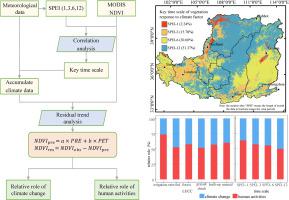Science of the Total Environment ( IF 9.8 ) Pub Date : 2020-09-21 , DOI: 10.1016/j.scitotenv.2020.142419 Shangyu Shi , Jingjie Yu , Fei Wang , Ping Wang , Yichi Zhang , Kai Jin

|
Vegetation is a crucial component of terrestrial ecosystems, and its changes are driven mainly by a combination of climate change and human activities. This paper aims to reveal the relationship between vegetation and climate change by using the normalized difference vegetation index (NDVI) and standardized precipitation evapotranspiration index (SPEI), and to find the cause of vegetation change by performing residual analysis on the Loess Plateau during the period from 2000 to 2016. The results showed that the NDVI on the Loess Plateau exhibited an increase of 0.086 per decade, and an increasing trend was observed across 94.86% of the total area. The relationship between the NDVI and SPEI was mainly positive, and the correlation increased as the time scale of the SPEI lengthened, indicating that long-term water availability was the major climate factor affecting vegetation growth. Residual analysis indicated that climate change was responsible for 45.78% of NDVI variation, while human activities were responsible for 54.22%. In areas with degraded vegetation, the relative roles of climate change and human activities were 28.11% and 72.89%, respectively. In addition, the relative role of climate change increased with an increase in the time scales, implying that the long-term NDVI trend was more sensitive to climate change then the short-term trend. The results of this study are expected to enhance our understanding of vegetation changes under climate change and human activities and provide a scientific basis for future ecological restoration in arid regions.
中文翻译:

黄土高原上多个时间尺度上气候变化和人类活动对植被变化的定量贡献
植被是陆地生态系统的重要组成部分,其变化主要由气候变化和人类活动共同驱动。本文旨在利用归一化植被指数(NDVI)和标准降水蒸发蒸腾指数(SPEI)揭示植被与气候变化之间的关系,并通过对黄土高原地区在此期间的残留分析,找出植被变化的原因。从2000年到2016年。结果表明,黄土高原的NDVI每十年增加0.086,并且在总面积的94.86%处观察到增加趋势。NDVI与SPEI之间的关系主要为正,并且随着SPEI时间尺度的延长,相关性增加,表明长期的水供应是影响植被生长的主要气候因素。残差分析表明,气候变化占NDVI变化的45.78%,而人类活动占54.22%。在植被退化的地区,气候变化和人类活动的相对作用分别为28.11%和72.89%。此外,气候变化的相对作用随着时间尺度的增加而增加,这意味着长期NDVI趋势比短期趋势对气候变化更为敏感。这项研究的结果有望加深我们对气候变化和人类活动下植被变化的理解,并为干旱地区未来的生态恢复提供科学依据。残差分析表明,气候变化占NDVI变化的45.78%,而人类活动占54.22%。在植被退化的地区,气候变化和人类活动的相对作用分别为28.11%和72.89%。此外,气候变化的相对作用随着时间尺度的增加而增加,这意味着长期NDVI趋势比短期趋势对气候变化更为敏感。这项研究的结果有望加深我们对气候变化和人类活动下植被变化的理解,并为干旱地区未来的生态恢复提供科学依据。残差分析表明,气候变化占NDVI变化的45.78%,而人类活动占54.22%。在植被退化的地区,气候变化和人类活动的相对作用分别为28.11%和72.89%。此外,气候变化的相对作用随着时间尺度的增加而增加,这意味着长期NDVI趋势比短期趋势对气候变化更为敏感。这项研究的结果有望加深我们对气候变化和人类活动下植被变化的了解,并为干旱地区未来的生态恢复提供科学依据。气候变化和人类活动的相对作用分别为28.11%和72.89%。此外,气候变化的相对作用随着时间尺度的增加而增加,这意味着长期NDVI趋势比短期趋势对气候变化更为敏感。这项研究的结果有望加深我们对气候变化和人类活动下植被变化的了解,并为干旱地区未来的生态恢复提供科学依据。气候变化和人类活动的相对作用分别为28.11%和72.89%。此外,气候变化的相对作用随着时间尺度的增加而增加,这意味着长期NDVI趋势比短期趋势对气候变化更为敏感。这项研究的结果有望加深我们对气候变化和人类活动下植被变化的理解,并为干旱地区未来的生态恢复提供科学依据。


























 京公网安备 11010802027423号
京公网安备 11010802027423号